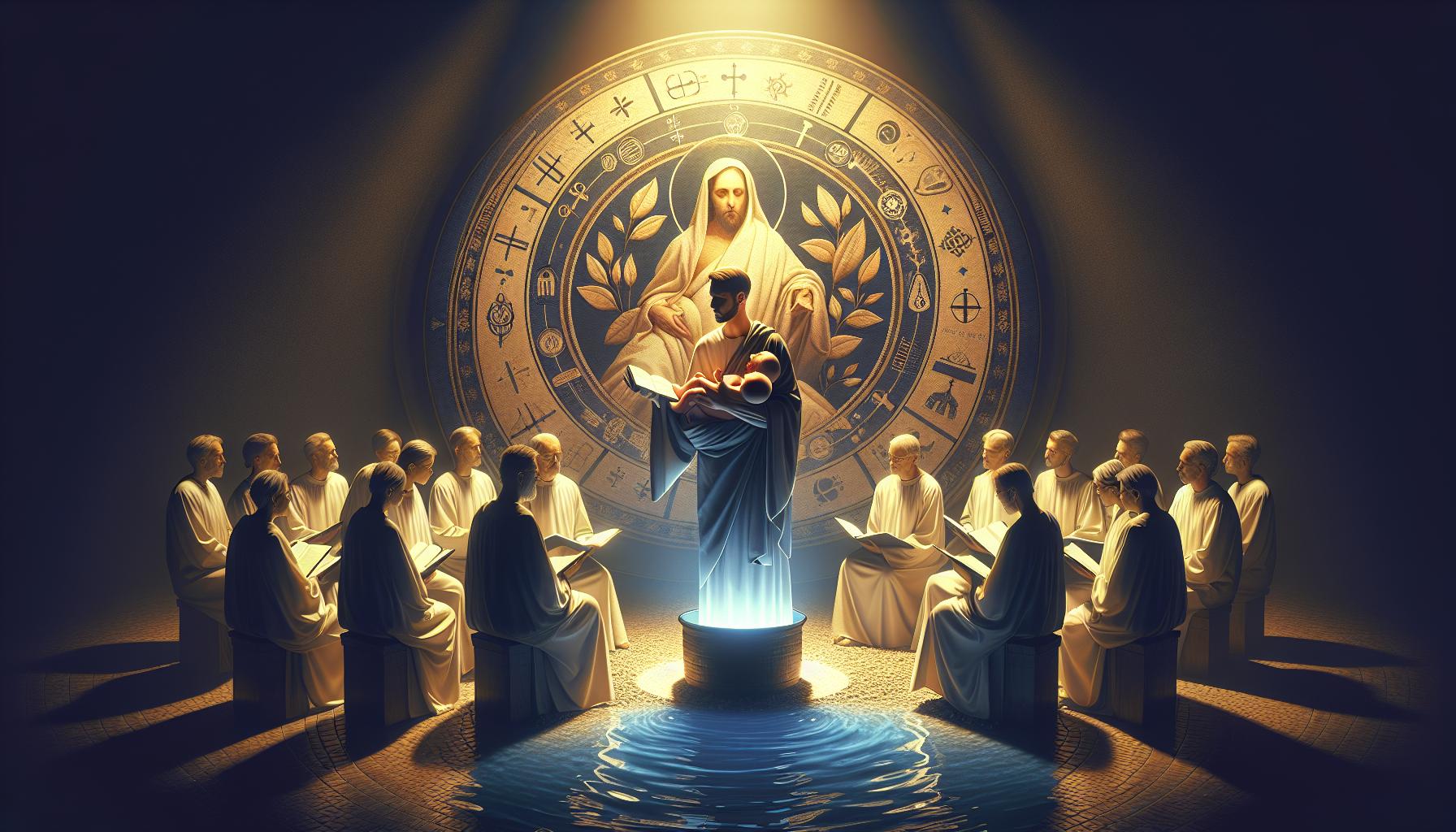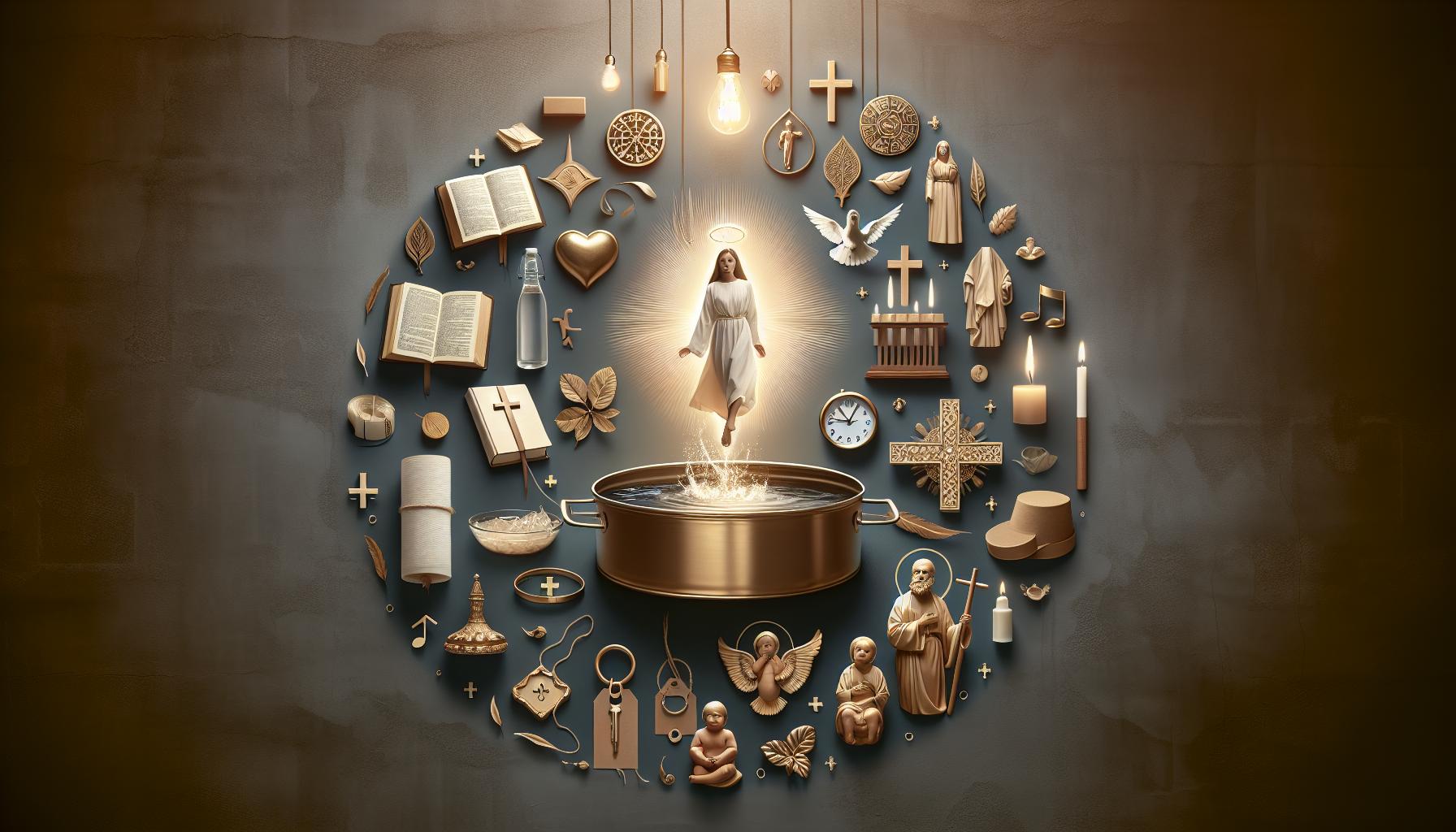Curious about the typical duration of a baptism service and what to expect? Understanding the length and structure of the ceremony can alleviate uncertainties, whether you’re a parent planning for your child or an adult exploring faith. This guide will walk you through the essential elements and help you feel prepared for this meaningful occasion.
Understanding the Purpose of Baptism: A Shared Tradition Across Faiths

Baptism has long been a practice that transcends individual faiths, with roots in various cultural and religious traditions. This sacred ritual often symbolizes purity, rebirth, and acceptance within a community, serving as a significant milestone in the lives of many believers. Understanding the purpose of baptism can deepen one’s appreciation for the ceremony and its associated customs, particularly when considering how long a baptism service lasts and what participants can expect.
Shared Significance Across Faiths
Baptism is not solely a Christian practice; several religious traditions highlight the importance of water and ceremonial rites. Here are a few examples of how different faiths interpret baptism-like traditions:
- Christianity: Seen as an outward demonstration of faith, baptism signifies the cleansing of sins and the initiation of the believer into the church community.
- Judaism: The ritual of mikveh involves immersion in a pool of water for spiritual renewal, although it serves different purposes from baptism.
- Hinduism: Ritual baths in sacred rivers symbolically purify the devotee and absolve them of past sins, paralleling the cleansing aspect of baptism.
- Buddhism: The water ceremony during ordination represents the purification of the mind and a commitment to a new spiritual path.
These varied traditions reflect a universal theme: the transformative power of water as a symbol of cleansing, rebirth, and spiritual awakening, highlighting a shared human experience tied to rituals that promote communal identity and individual renewal.
Examining the Duration and Expectations
When considering the question of how long a baptism lasts, service duration may vary greatly depending on the faith tradition, church denomination, or specific customs practiced. On average, a baptism service typically ranges from 30 to 90 minutes. Below is a general breakdown of what participants might expect during a typical baptism ceremony:
| Component | Approximate Duration |
|---|---|
| Welcome & Introduction | 5-10 minutes |
| Reading of Scriptures | 10-15 minutes |
| Baptismal Ceremony | 10-20 minutes |
| Closing Remarks & Prayers | 5-15 minutes |
Understanding the flow of the service not only helps participants to prepare mentally and emotionally but also allows them to witness the profound communal recognition of faith through the ritual of baptism. Whether one is participating as a candidate or offering support as a guest, the shared purpose of celebration and dedication resonates deeply across the diverse landscapes of faith traditions.
Typical Structure of a Baptism Ceremony: What Happens Step by Step
Baptism is a significant milestone in many religious traditions, celebrated with deep meaning and cherished rituals. Families often wonder not only about the significance of the ceremony but also about the expected structure and duration of the event. Understanding the typical flow of a baptism can provide insight into what to expect and how to prepare for this sacred occasion.
Preparation and Gathering
Before the baptism begins, guests typically arrive and take their seats. The ambiance may be decorated with floral arrangements or symbols of faith, adding to the spiritual atmosphere. It’s common for the ceremony to start with a welcoming by the officiant, who will set the tone for the service and provide an overview of what to expect. This introductory segment can last anywhere from 5 to 10 minutes.
During this time, families should ensure that everything is in place, including attire for both the baptized individual and any sponsors or godparents. Guests can take this opportunity to settle in and perhaps reflect on the meaning of baptism in their own lives, creating a communal vibe as they prepare for the next steps in the ceremony.
Ceremony Components
The baptism ceremony itself is structured around several key components, which may vary slightly depending on the specific religious tradition. Here’s a typical sequence of events that often unfolds:
- Opening Prayers: The officiant usually begins with a prayer, inviting the congregation to join in.
- Scripture Readings: Relevant passages from holy texts are read, often emphasizing themes of renewal and spiritual growth.
- Rite of Baptism: This is the central part of the ceremony, where the individual is baptized with water, symbolizing purification and initiation into the faith.
- Affirmation of Faith: Godparents or sponsors affirm their commitment to support the baptized person’s spiritual journey.
- Blessings and anointing: In some traditions, the individual may be blessed or anointed with oil as a sign of being set apart for a holy purpose.
- Closing Prayers and Blessing: The ceremony usually concludes with prayers and a blessing for the newly baptized, asking for guidance and protection.
This entire sequence can take anywhere from 30 to 60 minutes, depending on the specific rites and traditions of the faith involved.
Celebration and Fellowship
Following the formal ceremony, many families host a gathering to celebrate this important occasion. This part may include light refreshments, cake, and time for guests to mingle and share their good wishes. It’s an opportunity to reinforce community ties and celebrate the new spiritual journey together. In essence, the fellowship that follows serves to underscore the importance of community in one’s faith.
While you may have questions about how long a baptism lasts, understanding the typical structure of the ceremony can greatly enhance your experience. Whether you are a participant or a guest, knowing what to expect helps set the stage for a meaningful experience filled with joy, spirituality, and connection.
Time Investment: How Long Should You Expect a Baptism to Last?

Understanding the time commitment involved in a baptism can help families plan their schedules effectively. While each denomination and church can have varying practices, it’s generally safe to expect that a baptism ceremony will last between 30 minutes to 1 hour. This duration typically includes the liturgical elements, any sermons, and potentially a reception or gathering afterward. Knowing this information can empower families to maximize the experience while allowing for other activities in their day.
The Structure of a Baptism Ceremony
Several key components contribute to the overall length of a baptism, which can typically be broken down into the following elements:
- Welcome and Opening Remarks: This part sets the tone, usually lasting about 5-10 minutes.
- Reading of Scripture: Expect around 5-10 minutes for this important solemn aspect of the service.
- Sermon or Reflection: A short sermon may be included, which can range from 10-15 minutes.
- Baptismal Rite: The actual baptism, which includes the anointing and water blessing, typically takes up about 10-15 minutes.
- Candle Lighting and Blessings: Additional rituals may take another 5-10 minutes.
- Closing Prayers and Blessings: This can wrap up the ceremony in about 5 minutes.
Factors Influencing Duration
While the aforementioned breakdown gives a general idea, several factors can affect the overall time commitment:
- Additional Rituals: Some churches may include extra symbolic acts such as confirmation or communion, which can add time.
- Congregational Size: If multiple children are being baptized during a single service, the ceremony can take longer due to the added participants.
- Personal Touches: Families often choose to personalize a service with songs, readings, or testimonials, which can extend the duration.
A clear communication from the church regarding the service duration can significantly ease planning, particularly for guests who may have other commitments.
By having a good grasp of how long a baptism typically lasts, families can not only prepare appropriately but also ensure they’re able to make the most of this meaningful occasion without the stress of time constraints. This is particularly important when considering after-service gatherings where friends and family may want to celebrate together.
Preparing for the Day: Practical Tips for Participants and Guests

In preparing for a baptism, many participants and guests often wonder, “How long is a baptism, and what can I expect during this special service?” Understanding the average duration and structure of a baptism can help ease any anxiety and enhance the overall experience. Whether you’re a parent, godparent, or family friend, being informed will help you to be well-prepared for this meaningful day.
Essential Tips for Participants
If you are directly involved in the baptism, it’s advantageous to prepare in advance to ensure the ceremony runs smoothly. Here are some critical steps:
- Confirm the Schedule: Baptisms can vary in length, typically lasting anywhere from 30 minutes to over an hour, depending on the tradition and the church’s specific practices. Make sure to check with the officiant regarding the exact timing.
- Practice the Ceremony: If you are a parent or godparent, it can be beneficial to rehearse any readings or prayers in advance. Familiarity will help you feel more confident during the service.
- Dress Appropriately: Traditional attire is often expected, which might include formal wear for adults and smart clothing for children. Ensure that your outfit is comfortable as ceremonies can sometimes be longer than expected.
Guidelines for Guests
As a guest, there are several ways to ensure that you contribute positively to the baptism experience while also enjoying the day. Consider the following tips:
- Arrive Early: To avoid any disruptions, arrive at least 15-20 minutes before the scheduled start time. This gives you a chance to find a seat and settle in before the ceremony begins.
- Be Respectful: Remember that a baptism is a sacred event. Maintain a respectful demeanor, refrain from loud conversations, and turn off your mobile devices.
- Gift Consideration: While not mandatory, a thoughtful gift for the family can offer your support and love. Consider items like personalized mementos, religious books, or contributions to a future savings account for the child.
What to Expect During the Ceremony
Understanding the flow of the baptism can help participants and guests feel more at ease. While each church may have slightly different customs, here is a general overview of what to expect:
| Order of Service | Duration |
|---|---|
| Welcome & Introduction | 5 minutes |
| Reading of Scripture | 5-10 minutes |
| Baptismal Rite | 15-20 minutes |
| Prayers & Blessings | 5-10 minutes |
| Ceremony Conclusion | 5 minutes |
This structured approach not only helps participants feel prepared but also enables guests to understand their role in the day’s events, ensuring that everyone can celebrate thoughtfully together.
Spiritual Significance: What Baptism Represents in Different Denominations
The act of baptism holds profound meaning across various Christian denominations, symbolizing not just a rite of passage but also a deep spiritual transformation. This sacred ceremony often heralds a person’s journey of faith, making it a pivotal moment in their spiritual life. Understanding the spiritual significance behind baptism can provide greater insight into what to expect during the ceremony and highlight its relevance within different communities.
Symbolism Across Denominations
For many Christians, baptism represents purification, rebirth, and initiation into the faith community. Here are some of the distinct interpretations among major denominations:
- Roman Catholicism: Baptism is viewed as a sacrament necessary for salvation, cleansing original sin and welcoming the individual into the Church. It is often accompanied by the rite of Confirmation, creating a lifelong commitment to the faith.
- Protestantism: Many Protestant denominations see baptism as an act of obedience and a public declaration of faith. It serves as a symbol of the believer’s identification with Christ in His death and resurrection.
- Orthodox Christianity: In Orthodox traditions, baptism is part of a threefold sacrament (Baptism, Chrismation, and Eucharist), emphasizing the complete transformation and union with Christ. It often occurs shortly after birth, symbolizing the child’s entrance into the Christian life.
- Baptist Churches: Baptists adhere to “believer’s baptism,” asserting that one must profess faith before undergoing the ritual. This emphasizes a personal relationship with Jesus Christ, marking a definitive moment in their spiritual journey.
Common Practices and Their Meanings
The practices surrounding baptism differ significantly, yet they all serve to underscore the significance of this sacred act. Here’s a comparative overview of baptism practices among key denominations:
| Denomination | Baptism Type | Age of Baptism | Key Symbolism |
|---|---|---|---|
| Roman Catholic | Infant Baptism | Infants | Original Sin Cleansing |
| Protestant | Semi-Infant/Believer’s Baptism | Varies, often 12+ for believers | Public Declaration of Faith |
| Orthodox | Infant Baptism | Infants | Entry into Christian Life |
| Baptist | Believer’s Baptism | Above 12, upon confession | Personal Faith Commitment |
As evidenced by the variety of practices and beliefs surrounding baptism, this act is not merely a ceremonial formality but serves as a vital expression of faith and communal identity. For those contemplating baptism, understanding these spiritual dimensions can enhance the experience and instill a deeper appreciation for the commitments being made, as well as what to expect during the service.
Customs and Variations: Exploring Baptism Practices Around the World
Across the globe, baptism stands as a powerful symbol of faith, community, and personal transformation. Yet, the specific customs and practices surrounding this sacred rite can vary dramatically from one culture to another, reflecting the diverse traditions and beliefs of each region. In exploring the ways different cultures approach baptism, one can gain a deeper appreciation for the significance of this ritual while also understanding how the duration and proceedings may differ.
Western Traditions
In many Western Christian denominations, baptism is commonly practiced with an emphasis on ceremonial aspects. It is typically marked by a service lasting anywhere from 30 to 60 minutes. In churches such as those within the Catholic, Protestant, and Orthodox traditions, the infant baptism often entails:
- Welcome and Invocation: A greeting to the congregation and invocation of the Holy Spirit.
- Affirmation of Faith: Parents and godparents affirm their commitment to raise the child in the faith.
- Baptismal Rite: The actual baptism performed by pouring water over the candidate’s head, accompanied by a blessing.
Eastern Orthodox Practices
In stark contrast, Eastern Orthodox baptisms are more elaborate and can extend well beyond an hour. This tradition includes a series of rich rituals, such as:
- Triple Immersion: The infant is fully immersed in water three times to symbolize the Holy Trinity.
- Holy Chrism: Following the baptism, oil is applied to the infant, marking them as a member of the church.
- Tradition of Naming: Names are often given during this ceremony, adding a meaningful layer to the event.
Global Perspectives on Baptism
Outside the Western world, the customs surrounding baptism provide fascinating insights into local beliefs. For instance, in many African cultures, baptism may be integrated into community celebrations with vibrant music and dance, often including an immersion ceremony that lasts several hours. In an indigenous Filipino context, baptisms can be part of a larger festival, combining traditional rituals with spiritual dimensions that reflect the community’s ties to nature.
| Culture | Baptism Format | Duration |
|---|---|---|
| Western Christianity | Infant Baptism, Water Pouring | 30-60 minutes |
| Eastern Orthodox | Triple Immersion, Holy Chrism | 1-2 hours |
| African Traditions | Community Celebration, Immersion | Several hours |
| Indigenous Filipino | Integrated Festival Celebration | Varies |
By understanding these variations in baptism practices around the world, one can come to appreciate the depth and richness of this sacred tradition. Whether you’re planning a baptism or simply exploring the meaning behind it, acknowledging these global differences can enrich your understanding of what to expect during a baptism ceremony.
Navigating Emotional Milestones: Experiences Related to Baptism
The journey of baptism is not merely a rite of passage; it’s a profoundly emotional milestone brimming with anticipation, reflection, and joy. For many, this sacred event marks the beginning of a spiritual journey, creating lasting memories for both the individual being baptized and their family and friends. Understanding the emotional landscape surrounding baptism can help attendees better prepare for the ceremony and its significance in their lives.
Emotional Preparations
Before the day of the baptism, families often experience a whirlwind of emotions ranging from excitement to apprehension. On one hand, there’s the jubilation of welcoming a new member into the faith community. On the other, there may be anxiety surrounding questions like, “How long is a baptism service?” and “What should I expect during the ceremony?” Addressing these concerns beforehand can ease the emotional load. Here are a few ways to navigate this phase:
- Educate Yourself: Reach out to your religious leader for insights on the ceremony’s structure, including its duration and key moments you should anticipate.
- Involve Family: Include family members in planning and discussions to strengthen bonds and share the anticipation of the special day.
- Reflect: Encourage personal reflection on the meaningfulness of baptism and its implications for faith and community, transforming apprehension into encouraged participation.
During the Baptism Ceremony
As the baptism unfolds, the emotional experiences deepen. The moment when the individual—whether a child or an adult—is immersed in water or has water poured over them often evokes a profound sense of peace and connection. Witnessing this transformative act can leave attendees feeling spiritually uplifted and united in purpose. Here’s what typically happens during the service:
| Moment | Description |
|---|---|
| Invocation | A welcoming address often accompanied by prayers that set a solemn and reverent tone. |
| Readings and Reflections | Scriptural readings or personal reflections that highlight the importance of baptism and faith. |
| The Baptism | The actual baptism, whether through immersion, pouring, or sprinkling of water, is the pivotal moment of the service. |
| Community Affirmation | A moment where the congregation is invited to affirm their support for the newly baptized. |
Each of these moments is imbued with emotional significance, reinforcing the commitment made not only by the individual but by the community surrounding them. The recognition of support from family, friends, and the congregation can amplify the feelings of belonging and devotion.
Embracing the emotional milestones associated with baptism enriches the experience, making it much more than just a service. Preparing mentally and spiritually for this event allows individuals and their communities to engage fully, celebrating faith, unity, and personal transformation.
After the Baptism: Next Steps for New Members and Families
The experience of baptism is a significant milestone, not just for the individual but also for families and the wider faith community. Once the water is sprinkled and the vows have been made, many are left wondering what comes next. Understanding the next steps after the baptism ceremony encompasses both spiritual growth and community integration, setting the stage for a fulfilling journey of faith.
Engaging with the Faith Community
After baptism, it is vital for both new members and their families to root themselves in the community. Getting involved can seem daunting, but there are several welcoming avenues to explore:
- Join a Bible Study or Faith Group: Connecting with others can deepen your understanding and strengthen relationships within the congregation.
- Participate in Church Activities: Attend events such as potlucks, volunteer opportunities, and community outreach projects. These gatherings allow for fellowship and integration.
- Seek Mentorship: Finding a mentor within the church can provide personalized guidance and support as you navigate your faith journey.
Nurturing Your Spiritual Growth
Baptism marks the beginning of a lifelong spiritual journey, and new members should consider various ways to nourish their faith. Here are some practical suggestions:
- Regular Worship Attendance: Make it a habit to gather for weekly services. This not only reinforces your commitment but also immerses you in communal worship and teaching.
- Personal Devotions: Establish a routine for daily scripture reading or prayer. Resources like devotional books or apps can help guide your practice.
- Education Opportunities: Look out for classes and workshops offered by your church that explore aspects of faith, theology, and discipleship.
Involving Your Family
For families, post-baptism activities can enhance the spiritual experience together. Consider the following actions to foster a shared faith journey:
- Family Devotion Time: Set aside time each week for family discussions and activities around scripture, prayer, or faith-based projects.
- Service Projects: Engage in community service as a family. This reinforces the values of compassion and service in a tangible way.
- Celebrate Milestones: Mark other special occasions in faith, such as First Communion or Confirmation, to create a tradition of active faith participation.
Planning for Future Sacraments
As family members grow in their faith, it’s essential to look ahead to future sacraments and milestones. Discussing plans for events such as First Communion or Confirmation can provide a framework for spiritual development. Consider these steps:
| Milestone | Preparation Steps |
|---|---|
| First Communion | Attend classes offered by the church; participate in family discussions about the significance of the sacrament. |
| Confirmation | Engage with a mentor from the church; participate in confirmation classes to deepen understanding of faith. |
By taking these steps after baptism, new members and their families can deepen their connection to their faith and community, ensuring their journey is rich and fulfilling.
Q&A
How long is a baptism service?
The duration of a baptism service typically ranges from 30 minutes to an hour, depending on the church and the specific practices involved. Some services may be shorter, while others might include additional worship elements that extend the time.
Baptism services often include elements such as music, prayers, and scripture readings. Churches may also involve the congregation in the ceremony, which could contribute to the duration. It’s recommended to check with your local church for the exact timing and structure of their baptism services.
What should I expect during a baptism?
During a baptism, expect a solemn yet celebratory atmosphere filled with community support. Key elements include the ritual itself, scripture readings, and sometimes a sermon about the significance of baptism.
Families and guests often participate by witnessing the event and providing support. Many services will also include a moment for the congregation to affirm their commitment to the baptized individual. For a deeper understanding, consider reviewing the spirituality behind *baptism* and its meaning within various faiths.
Can I take photos during a baptism?
Whether you can take photos during a baptism usually depends on the specific church policies. Some churches encourage capturing memories, while others may prefer to maintain a solemn environment free of distractions.
It’s best to ask the church beforehand about their photography guidelines. Respecting the sanctity of the occasion is crucial, so if allowed, aim to take candid shots without disrupting the service.
Why does baptism vary in length?
The length of a baptism service can vary due to several factors, including the denomination, specific church traditions, and whether additional rituals are included. Churches with elaborate traditions may have longer services.
Some denominations perform *infant baptisms* that may include specific rites, while others focus on adult baptisms that can also include personal testimonies. Each church’s approach shapes how long the service lasts.
What is involved in a baptism ceremony?
A typical baptism ceremony includes several elements: the invocation, scripture readings, the actual baptism (usually involving water), blessings, and congregational responses. The exact elements may differ among denominations.
In many churches, the pastor or priest invites the congregation to participate, emphasizing the community’s role in supporting the individual’s faith journey. Understanding these components can enrich your appreciation for this sacred ceremony.
How can I prepare for a baptism?
Preparing for a baptism involves spiritual and practical steps. Spiritually, individuals often meet with their clergy to discuss the significance of baptism. Practically, you’ll need to arrange attire for the baptism and inform family and friends.
Some may also choose to write personal reflections or prayers to share during the ceremony. For more practical tips and guidance on preparation, see our comprehensive guide on *baptism preparation*.
Can I be baptized more than once?
In Christian theology, baptism is generally viewed as a one-time sacrament. However, some individuals choose to be re-baptized for various personal or spiritual reasons, depending on their faith community’s beliefs.
Re-baptism often symbolizes a renewed commitment to faith or a transformative experience. It’s best to consult your church or pastor for guidance if you’re considering this path.
The Conclusion
As we conclude our exploration of baptism, we’ve navigated the importance and significance of this sacred rite, along with its duration and what one can expect during the service. From its rich theological implications to the practical aspects of preparation and participation, we hope this guide has illuminated the path for both individuals and families considering baptism.
Whether you are stepping into the waters of faith for the first time or supporting a loved one on their journey, remember that each baptism is a unique reflection of a community’s commitment to nurture spiritual growth. We invite you to continue this journey with an open heart, seeking deeper understanding and connection within your faith tradition.
Engage with your community, ask questions, and explore resources that can further enrich your experience. Your journey in faith is just beginning, and we encourage you to embrace all that the sacrament of baptism has to offer. May your path be blessed with insight, joy, and fellowship as you navigate this profound milestone.





